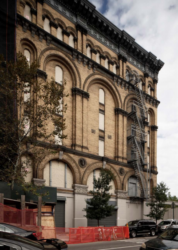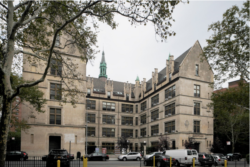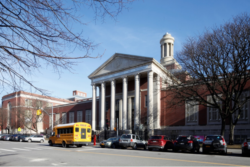
Former Webber Packing House.
The landmarking of two buildings constructed as schools and a former meatpacking plant receive support at public hearing. On February 13, 2018, Landmarks held hearings on the potential designations of three structures as individual City landmarks in the East Harlem neighborhood of Manhattan. The three buildings are the former Richard Webber Harlem Packing House, at 207 East 119th Street; the former Public School 109, at 215 East 99th Street; and the former Benjamin Franklin High School, at 260 Pleasant Avenue. The buildings were identified by landmarks staff in a survey of the area’s historical and architectural resources as part of the East Harlem Neighborhood Plan and anticipated East Harlem Rezoning.
The three buildings were added to Landmarks calendar at its meeting in November of 2017.
The 1895 Packing House, designed by Bartholomew and John Peter Walther, is the sole remaining structure in what was once a much larger complex, housing retail space, a slaughterhouse, and meatpacking facilities. The company was founded by Richard Weber, an English immigrant who started in the industry with a small butcher shop. He ultimately employed 500 people and was thought to be one of the largest butchers in the nation at the time of his death. The Romanesque Revival building, with its tripartite brick facade, was intended to present a sophisticated aspect to the public. Decorative details include a projecting denticulated cornice with a paneled frieze, roundels, and terra cotta cow head reliefs alluding to the building’s use.
The building currently serves as a plumbing supply warehouse and showroom.
Connie Lee, of the Marcus Garvey Park Alliance, said the property merited designated as one of the few remnants of a once-thriving industry in the area, which “tells the story of a working-class neighborhood.” Sarah Kamillato, speaking for Friends of the Upper East Side Historic Districts, noted that the building retained its original brickwork and ornamentation, and remained highly visible and intact. The New York Landmarks Conservancy’s Andrea Goldwyn called the Packing House an elevated example of a 19th-century industrial building. Goldwyn commended Landmarks for working in conjunction with City Planning, in an area underrepresented in landmark designations and facing development pressure.

Former Public School 109, now El Barrio’s Artspace PS109.
The formers Public School 109, now El Barrio’s Artspace PS109, was constructed in 1899 to designs by C.B.J. Snyder, the Superintendent of School Buildings, and architect behind several other individually designated institution structures. The Collegiate Gothic building utilizes Snyder’s innovative “H-plan,” with a central block flanked by two parallel wings creating two street-facing courtyards, maximizing light and air to interiors while creating recreational student space. The brick-and-limestone-clad school features terra-cotta stringcourses, and medievalizing terra-cotta ornaments such as gargoyles, as well as large windows made possible through steel-frame construction.
The school closed in 1996. It was redeveloped by Artspace and reopened in 2015 as housing and studios for artists, with exhibition and performance spaces.
Friends’ Kamillato discussed the building’s history since the school’s closure, testifying that it had been slated for demolition, but the community fought for its retentions and reuse, “in a way that would foster creativity and well-being in East Harlem.” She called it “a powerful case study for adaptive reuse.” Andrea Goldwyn said that the building exemplified the significant qualities of Snyder’s approach to school construction, with its facade announcing to the neighborhood that it is “a grand, special place.” Joanna Delson of Civitas said the building was an important survivor of the mid-century urban renewal era which reshaped East Harlem and saw the destruction of many other institutional buildings. The Historic District Council’s Patrick Waldo noted that the building had been identified in the Bloomberg Administration’s PlaNYC as a preservation priority in 2007.

Former Benjamin Franklin High School, now Manhattan Center for Science and Mathematics.
The Benjamin Franklin High School was constructed in 1942 in a Georgia Revival style to designs by architect Eric Kebbon and is prominently sited on the East River. Aside from its architecture, the site is also significant for its history of novel pedagogical techniques in engaging immigrant students and community members, under the guidance of Principal Leonard Covello. Covello, informed by the Settlement House Movement, believed in the link between education and social activism. He led innovative bilingual programs catering to the then-largely Italian immigrant population, invited parents and community members to participate in the scholastic life, and also held outreach events in the community. As the area’s demographics changed, Covello adapted his methods to meet the need of students and community members from Puerto Rico, conducting Spanish-language outreach and orientations, and forming a Puerto Rican cultural club.
The building is still used for educational purposes, and currently houses the Manhattan Center for Science and Mathematics.
Robert Ragone, of the Vito Marcantonio Forum, spoke about the significance of Leonard Covello as the City’s first Italian-American high school principal and his use of community-centered learning and embrace of pluralism. Ragone said Covello “changed the way we should think about school,” and urged the Commission to swiftly designate the property. The HDC’s Waldo echoed these sentiments, testifying that “this school consciously celebrated the contributions of immigrants and advocated for the retention of their cultures and languages…for the collective benefit of society.” A representative of Landmark East Harlem endorsed designation and noted that the building possessed a unique rooftop greenhouse and was the Alma Mater of Senator Daniel Patrick Moynihan.
Chair Meenakshi Srinivasan said Lott Community Development, as well as some area residents, had communicated their support for the designations to the Commission via letter.
Srinivasan closed the hearing without establishing a date for a vote on the designations.
LPC: Richard Webber Harlem Packing House, 207 E. 119th Street, Manhattan (LP-2595); Public School 109, 215 E. 99th Street, Manhattan (LP-2597); Benjamin Franklin High School, 500 E. 116th Street, Manhattan (LP-2596) (Feb. 13, 2018).
By: Jesse Denno (Jesse is a full-time staff writer at the Center for NYC Law).

